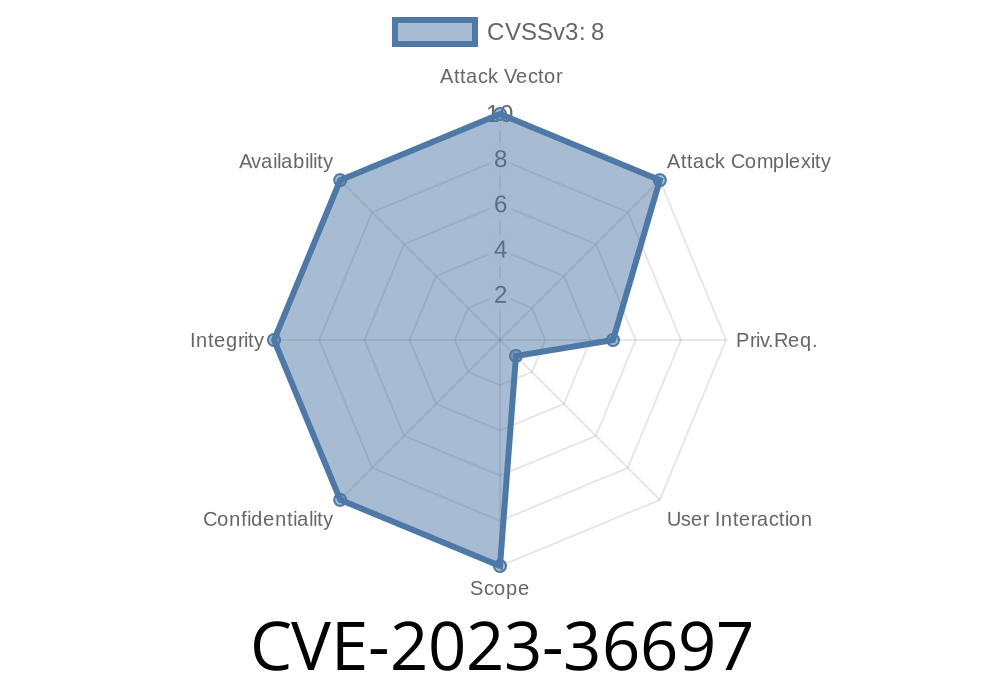---
When you think of instant messengers, WhatsApp or Telegram might ring a bell. But, under the hood of countless business apps, a quiet Microsoft service called Message Queuing (MSMQ) has pushed messages across networks, pretty much unnoticed—until now. In 2023, a critical vulnerability, CVE-2023-36697, rocked MSMQ users by offering remote attackers a way to execute code on unpatched Windows systems. This post breaks down how the exploit works, what makes it scary, and how you can keep your systems safe.
What Is CVE-2023-36697?
CVE-2023-36697 is a Remote Code Execution (RCE) vulnerability found in Microsoft Message Queuing (MSMQ). Attackers can send a specially crafted MSMQ packet to a vulnerable server, enabling them to potentially run any code they wish—meaning they could install programs, change data, or create new user accounts with full user rights.
Why Should You Care?
- MSMQ is installed by default on a lot of Windows systems, especially those running older line-of-business apps.
No user interaction is needed for exploitation, making it a high-risk vulnerability.
- Attack surface is broad: Any machine with port 1801/TCP open and MSMQ running is a target.
How Does the Exploit Work?
If attackers can reach your MSMQ server (default on port 1801/TCP), they can send a specially crafted message that takes advantage of improper message processing in MSMQ. The underlying issue is a heap buffer overflow, allowing arbitrary code execution.
Microsoft’s official security advisory describes it as
> "*An attacker who successfully exploited this vulnerability could execute arbitrary code on the target server.*"
>
> — Microsoft Security Guide
Exploit Steps (Conceptual Walkthrough)
Let’s look at a simplified exploit flow (actual public Proof of Concepts may require advanced traffic crafting and are released at your own risk):
Handshake: The attacker initiates an MSMQ communication with the victim server.
3. Packet Crafting: A malicious payload is created—typically a message with an oversized or malformed header/field.
Send Packet: The payload is delivered to the server using simple socket code.
5. Code Execution: The server processes the message and, because of the flaw, executes the injected code.
Python example snippet *(for illustration only—do not use this in production!)*
import socket
# MSMQ server IP and port
target_ip = "192.168.1.100"
target_port = 1801
# Craft a malicious packet (contents are not an actual exploit)
payload = b"\x00" * 2048 # Oversized buffer, real exploit payloads are more complex
s = socket.socket(socket.AF_INET, socket.SOCK_STREAM)
s.connect((target_ip, target_port))
s.send(payload)
s.close()
Note: Actual exploit code is more sophisticated and tailored to precise memory overruns, but this shows how simple sending custom packets to the MSMQ port can be.
Apply Microsoft’s Patch Immediately
Go to Microsoft's Update Guide for CVE-2023-36697 and ensure your system is up to date.
Close Port 1801 If Not Needed
Use firewall rules to block outside access to port 1801/TCP.
More Technical Reading
- Microsoft Security Advisory for CVE-2023-36697
- NIST NVD Entry
- CERT/CC Note
- Hackread: MSMQ Zero-Day
Closing Thoughts
CVE-2023-36697 is a big reminder that even old, “boring” Windows services can turn into open doors for attackers. Patch now, check your firewalls, and retire MSMQ if you’re not actively using it. Stay safe and keep your stack lean!
P.S.: If you’re a sysadmin and want to be proactive, regularly audit all open ports and legacy services—you’ll likely dodge the next bullet!
*Written for security pros, IT admins, and anyone curious about real-world vulnerabilities lurking in their networks. For educational purposes only!*
Timeline
Published on: 10/10/2023 18:15:15 UTC
Last modified on: 10/13/2023 18:48:36 UTC
